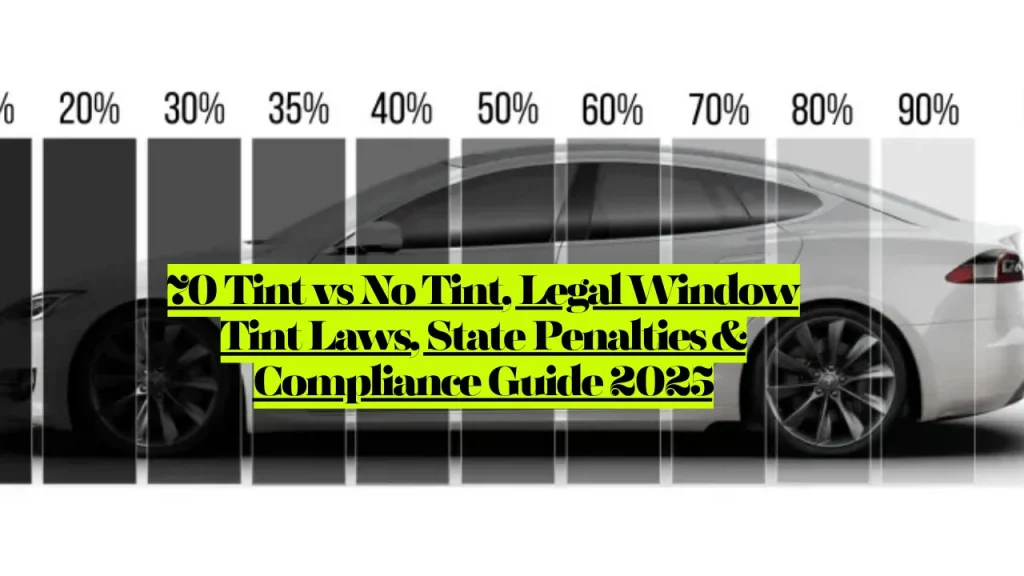70% Tint vs No Tint, Legal Window Tint Laws, State Penalties & Compliance Guide 2025
The legal difference between 70% tint and no tint is significant: 70% tint (allowing 70% Visible Light Transmission) blocks 30% of light, while untinted windows allow nearly 100% light passage. Only three states—California, New York, and Pennsylvania—require 70% VLT on front windows, making this the strictest legal standard in the U.S. Most states permit darker tints, but violations can result in fines ranging from $50 to several hundred dollars, “fix-it” tickets requiring removal, and failed vehicle inspections.
Understanding this distinction matters now because enforcement has tightened in several states due to safety concerns, with officers issuing more tickets for non-compliant tint using handheld tint meters during routine traffic stops.
What Does 70% Window Tint Mean?
Window tint percentage refers to Visible Light Transmission (VLT)—the percentage of light that can pass through the window film. A 70% VLT means 70% of light passes through, while 30% is blocked.
The lower the VLT percentage, the darker the tint. This creates confusion for many drivers: higher numbers mean lighter tint, not darker.
How 70% tint appears:
A 70% tint appears nearly transparent with a slight reduction in light. It’s the lightest tint level legally required and provides minimal visual darkness compared to popular darker shades like 35% or 20%.
Comparison to other tint levels:
- No tint: ~90-95% VLT (factory glass)
- 70% VLT: Lightest legal requirement in strictest states
- 50% VLT: Moderate tint, common for rear windows
- 35% VLT: Popular balance of privacy and visibility
- 20% VLT: Dark tint, illegal on front windows in most states
- 5% VLT: “Limo tint,” darkest available
Most manufacturer’s factory tint is no darker than 70% VLT. When adding aftermarket tint, you must calculate combined VLT by multiplying percentages. If factory glass is 80% VLT and you add 30% tint, the result is 24% VLT (.80 x .30 = .24).
Related article: NCAA Loses First-Ever Concussion Trial & Ordered to Pay $18M in Football Concussion Lawsuit, What the Jury Verdict Means

Is 70% Tint Legal? State-by-State Breakdown
Window tint legality varies dramatically by state and window location. There is only one state that allows people to tint their windows to any tint percentage: Michigan.
States Requiring 70% VLT on Front Windows
Only three states—New York, Pennsylvania, and Rhode Island—have a VLT limit of 70% for front side windows. These represent the strictest tinting laws in the nation.
California also requires 70% VLT for front side windows under Vehicle Code Sections 26708 and 26708.5, making it a fourth state with this strict standard.
States Allowing Darker Front Window Tint
Most states permit darker tints on front windows:
- Florida: 28% VLT front windows
- Arizona: 25% VLT front windows
- Texas: 25% VLT front windows
- Washington: 24% VLT front windows
- Oklahoma: 25% VLT front windows
- New Mexico: 20% VLT front windows (darkest)
- Michigan: 35% VLT front windows
State limits on front-side windows range from any amount (Michigan) to completely illegal (New Hampshire, New Jersey, Vermont).
Rear Window Regulations
States tend to be more lenient with back-side window tinting. At least 13 states allow any amount of tinting on rear windows. Most states permit between 10% and 50% VLT.
Pennsylvania and Rhode Island are the only two states requiring no more than 70% VLT for rear windows, matching their strict front window requirements.
Windshield Tinting Rules
Most states ban tint below the AS-1 line—a marking typically 4-6 inches from the windshield top. It is illegal to add any tinting to the windshield in Minnesota, New Jersey, and Pennsylvania.
States like North Dakota and Ohio allow tinting anywhere on the windshield as long as VLT exceeds 70%.
What Are the Penalties for Illegal Window Tint?
Fines typically range from $50 to several hundred dollars, depending on the state and number of offenses. First-time violations usually result in lower penalties, but repeat offenses escalate quickly.
California Penalties
First offense: $25 fine with a “fix-it” ticket requiring tint adjustment within a specific timeframe. If you fail to correct the tint and are pulled over again, you face harsher penalties including traffic infractions with heavier fines.
Repeated violations bring higher fines and may affect your driving record and insurance rates. Some insurers consider multiple violations when determining premiums.
Common Penalties Nationwide
First violation:
- $25-$100 fine
- “Fix-it” ticket with correction deadline
- Court appearance sometimes required
Repeat violations:
- $100-$500+ fines
- Failed vehicle safety inspections
- Points on driving record
- Increased insurance premiums
Some states include tint checks in annual safety inspections, meaning a non-compliant vehicle cannot pass until corrected.
Hidden Consequences
Insurance claims may be denied if an accident occurs in a car with illegal tint, and some manufacturers void warranties if the film does not meet legal standards.
If a driver causes an accident due to restricted visibility from excessive tint and has been issued a tint ticket but fails to adjust the tint, they can face penalties beyond liability for damages caused.
Related Article: Are Radar Detectors Legal in California? The Shocking Truth About Where You Can’t Mount Them
How Do Police Measure Window Tint?
Law enforcement uses tint meter devices during traffic stops to test vehicle window tint levels. The tool measures VLT percentage by touching the window surface to determine if tint exceeds darkness limits.
Tint Meter Technology
Many law enforcement agencies are now equipped with digital tint meters that can scan your windshield in seconds. These meters measure the amount of light passing through the glass as a percentage known as VLT (Visible Light Transmission).
Enforcement Process
A police officer may conduct a traffic stop if they notice a vehicle appearing to have excessive tint. The officer uses the tint meter to measure light transmission, and if the meter reads less than the legal limit, they issue a tint ticket.
The measurement accuracy depends on the quality of the device used by the police officer. Drivers should ensure their tint complies with state laws to avoid penalties.
What Triggers a Tint Stop
Officers typically initiate stops when:
- Windows appear significantly darker than legal limits
- Visibility into the vehicle is obstructed
- Tint appears non-compliant during routine traffic stops
- Vehicle fails inspection checkpoints
Medical Exemptions for Window Tinting
Most states offer medical exemptions allowing darker tints for individuals with light-sensitive medical conditions. These exemptions permit windows to be tinted darker than standard legal limits based on medical needs.
Qualifying Medical Conditions
Common qualifying conditions include:
- Lupus (Systemic Lupus Erythematosus)
- Albinism
- Xeroderma Pigmentosum
- Porphyria (severe light-sensitive condition)
- Photosensitivity from medications
- Melanoma and skin cancers
- Severe eczema or dermatitis
- Photophobia (light sensitivity from eye or neurological disorders)
New York permits exemptions for severe drug photosensitivity (if treatment is prolonged), photophobia associated with ophthalmic or neurological disorders, and any condition causing severe photosensitivity requiring shielding from direct sun rays.
How to Apply for Medical Exemption
The general process includes:
1. Consult your physician Schedule an appointment to discuss your specific condition necessitating medical exemption. Your healthcare provider evaluates whether your condition qualifies.
2. Obtain documentation Request a written statement from your licensed physician on letterhead including your diagnosis, specific medical condition, and recommendation for exemption, plus the physician’s contact information.
3. Complete state application Visit your local DMV office or access their website to obtain the necessary application. Fill out the application accurately with all required information and attach physician documentation.
4. Submit and pay fees Application fees vary by state: Georgia charges $10, Florida charges $6, and some states require no fees.
5. Await approval The DMV reviews your application and makes a decision based on provided information.
State-Specific Requirements
Florida’s medical exemption certificate has no expiration date and is non-transferable, becoming invalid upon vehicle sale or transfer.
Illinois requires licensed physician’s prescription or statement in the vehicle at all times, specifying minimum VLT percentage required and containing an expiration date no more than two years from issuance.
Georgia requires the physician’s letter to explain why the condition can only be addressed by a 9% reduction of visible light, not UV light. Conditions addressable through protective eyewear or legal-limit UV-blocking tint are not eligible.
How to Legally Tint Your Windows
Staying within the law starts with knowing specific tint regulations in your state. The most reliable sources are your state’s DMV website or official state code.
Step 1: Check Your State’s Laws
Consult a “Tint Laws By State Chart” outlining specific window tinting regulations including darkest legal tint percentages and VLT% allowed for different vehicle types.
Verify requirements for:
- Front side windows
- Rear side windows
- Rear windshield
- Front windshield (AS-1 line restrictions)
- Reflectivity limits
- Color restrictions
Step 2: Choose Compliant Tint
When choosing film, always confirm its VLT rating, reflectivity, and whether it’s allowed on the windshield above the AS-1 line.
California prohibits red, amber, and blue tints on all windows. Mirror-like or highly reflective films are also banned.
Step 3: Use Professional Installation
Professional installers are often updated with regulation changes and can ensure your tint meets legal standards. Reputable shops provide:
- Compliance documentation
- Manufacturer certification
- Warranty protection
- Proper VLT measurements
Step 4: Obtain Required Documentation
California requires a sticker displaying the tint manufacturer’s name and the installing firm’s information. This must remain visible to identify legal compliance.
Ask your installer for compliance documentation to show law enforcement if questioned.
Step 5: Account for Factory Tint
You must account for factory tint when adding aftermarket film. This is calculated by multiplying percentages. Failing to consider existing tint can result in illegal darkness levels.
Frequently Asked Questions
Q: Can I get pulled over just for window tint?
Yes. If your car’s window tint does not adhere to your state’s VLT laws, you can get pulled over by law enforcement. Officers use tint meters to measure VLT, and violations result in penalties.
Q: What’s the difference between 70% tint and no tint in actual appearance?
A 70% tint appears nearly transparent with only slight light reduction, looking very similar to untinted windows. The difference is barely noticeable to most observers. Untinted factory glass typically allows 90-95% light transmission.
Q: Is 70% tint legal in Texas?
No. Texas allows 25% VLT on front side windows, meaning you can legally use much darker tint than 70%. Texas regulations are more lenient than California, New York, or Pennsylvania.
Q: Does 70% tint block UV rays?
Yes, a 70% tint blocks some UV rays, though it won’t provide complete UV protection. It can reduce UV exposure to some extent. Most quality tints block 99%+ of UV rays regardless of darkness level.
Q: Can I drive through other states with my legal tint?
A tint that is perfectly legal at home may not be compliant elsewhere. This creates challenges for drivers traveling across state lines. You can be ticketed if your tint violates the state you’re driving through, even if legal in your home state.
Q: Will illegal tint void my car warranty?
Some manufacturers void warranties if the film does not meet legal standards. Check your vehicle warranty before tinting to understand potential impacts.
Q: How do I prove I have a medical exemption?
Licensed physician’s prescription or statement must be in the vehicle at all times in most states. Once granted an exemption certificate, it must remain visible in your car. Some states provide dashboard placards or certificates.
What Are Recent Changes to Tinting Laws?
In recent years, enforcement has tightened in several states due to safety concerns. This trend suggests stricter regulation could spread to other states in the future.
New York updated its medical exemption regulations in December 2017, expanding the list of qualifying conditions.
As of 2025, California and New York enforce tint laws aggressively with random roadside checks and increased use of digital tint meters. Officers can now measure compliance in seconds during routine stops.
Law enforcement’s increased focus on tint violations stems from safety concerns about officer visibility during traffic stops and driver visibility for safe operation.
Does Vehicle Type Affect Tint Laws?
Some vehicle types, like SUVs and vans, get more leeway with rear tints. Many states distinguish between passenger cars and multi-purpose vehicles.
States may impose different rules for passenger vehicles versus commercial ones. Verify your specific vehicle classification when researching tint regulations.
State laws often include specific exemptions, such as allowing darker tint on rear windows if the vehicle has side mirrors on each side.
What Should You Do If You Receive a Tint Violation?
Immediate steps:
- Don’t ignore the ticket. The sooner you correct the issue, the easier it is to avoid extra fines or legal complications.
- Verify the violation. Request to see the tint meter reading and compare against your state’s legal limits.
- Correct the tint quickly. Most jurisdictions issue “fix-it” tickets with a deadline to remove or adjust illegal tint.
- Obtain proof of correction. Save receipts showing tint removal or adjustment to present to the court.
- Consult an attorney if needed. If you’ve received a tint ticket or were involved in a crash where window tint is a factor, legal counsel can help.
For guidance on related traffic violations, consult resources on DUI programs and legal requirements or criminal defense attorneys specializing in traffic law.
Key Takeaways: 70 Tint vs No Tint
Legal framework:
- Only California, New York, Pennsylvania, and Rhode Island require 70% VLT on front windows
- 70% tint blocks 30% of light versus untinted glass at ~5-10% blockage
- Most states allow significantly darker tints
Penalties for violations:
- $50-$500+ fines depending on state and offense number
- Fix-it tickets with correction deadlines
- Failed inspections and insurance complications
Enforcement methods:
- Police use handheld tint meters measuring VLT percentage
- Increased enforcement with random roadside checks in strict states
Medical exemptions:
- Available in most states for light-sensitive medical conditions
- Require physician documentation and DMV application
- Fees range from $0-$10 depending on state
Compliance steps:
- Check state-specific regulations before tinting
- Use professional installers familiar with local laws
- Account for factory tint when calculating combined VLT
- Obtain and maintain required compliance documentation
For additional information on automotive legal compliance, see Kei truck street legality or vehicle modification laws.
Disclaimer: This information is for educational purposes only and does not constitute legal advice. Consult your state’s DMV or a traffic attorney for specific legal guidance regarding window tinting regulations in your jurisdiction. Laws change frequently, and compliance requirements vary by state.
Last Updated: October 27, 2025
About the Author

Sarah Klein, JD, is a licensed attorney and legal content strategist with over 12 years of experience across civil, criminal, family, and regulatory law. At All About Lawyer, she covers a wide range of legal topics — from high-profile lawsuits and courtroom stories to state traffic laws and everyday legal questions — all with a focus on accuracy, clarity, and public understanding.
Her writing blends real legal insight with plain-English explanations, helping readers stay informed and legally aware.
Read more about Sarah
